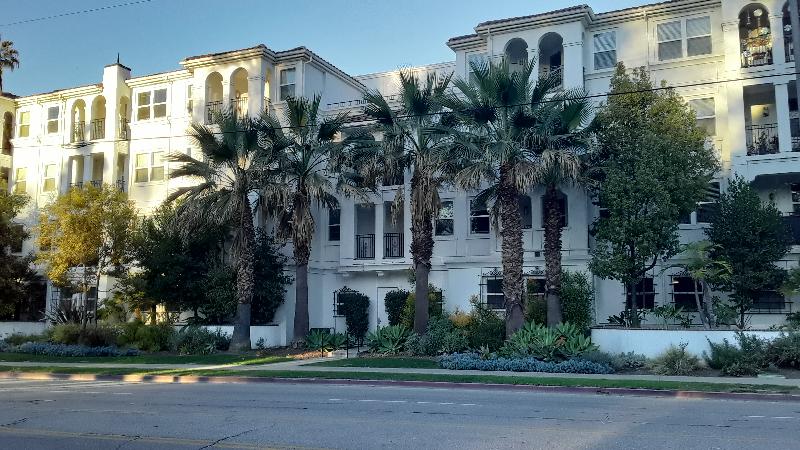
*It’s early morning in Echo Park, a once beautiful landmark near the proximity of the heart of Los Angeles’ biggest attraction, Hollywood. The promise of the sun glistens through the faint remnants of the previous night, and the sky begins to display its light blue hue, signaling the start of a new day. A few joggers decide to take advantage of the walkways that are synonymous with Echo Park, running slowly but intently, keeping their eyes strictly on the paved walkways ahead of them. A resident can be heard, doing his familiar morning routine, playing his boom box with the sounds of a popular of hip-hop artist blaring out of his residence, with the fountain, the centerpiece of Echo Park, as his own personal backdrop. The other residents of the small community begin to mull about, to begin their day.
The scenario is a typical day in Echo Park, with a notable exception.
The residents aren’t playing music from their homes, apartments or even rooms. They aren’t mulling about from their vacation homes, resorts, or even a cabin. In fact, the residents playing the music appear to not even to have an address – the people are awakening to their own everyday reality, awakening in their tents- tents situated among the many tent communities that are now becoming an unfortunate byproduct of bad choices, broken dreams, economic hardship and several other factors, including drug abuse, crime, mental illness and other mitigating factors. The residents in the tent communities of Echo Park echo a disturbing trend of thousands of Americans that have a very similar, but unfortunate plight. Echo Park is a stark example, a microcosm of a problem that is engulfing America.

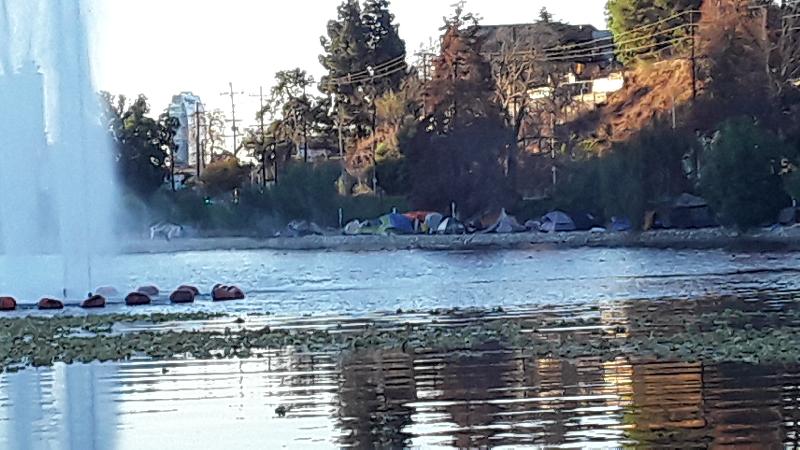
Homelessness in America – is a growing problem in the United States, a pervasive one – and Los Angeles is a prominent symbol of a countrywide crisis.
“The city of Los Angeles is the epicenter of homelessness in the County of Los Angeles, “said Los Angeles City Councilmember Mark Ridley-Thomas at a recent event, the Empowerment Congress in Los Angeles. “The County of Los Angeles is the epicenter of homelessness in the State of California, and the state of California is the epicenter of homelessness in the United States of America. Do the research, look at the data- each time you look at this we are the centerpiece of this crisis and we’ve got to step up.”
Echo Park, located in Central Los Angeles, between Hollywood and downtown Los Angeles, has always been known as one of Los Angeles’ most beautiful attractions, with culture, clubs and artistic storefronts. But now the park, the centerpiece of Echo Park, is an encampment, lined with hundreds of tents along every portion of the park, giving Echo Park the feel of a third world country, of refugees that have fled an oppressive regime or suffered at the hands of disease and famine. The reality, however, is that these conditions are not in a foreign country outside the borders of the United States. They are not conditions in Africa, Russia or Venezuela. The current condition of homelessness signals a terrifying and frightening prospect of a new normal for citizens of the United States. And with Covid-19 and eviction moratoriums ending at a finite date, homelessness is a ballooning problem. The irony of Echo Park presents a contrasting yet contradictory vision- the visage of opulence on one side of a street of Echo Park, versus the visage of human suffering on the opposite side of the street.
Echo Park could be considered a glaring example, a signal of homelessness in Los Angeles, however, homelessness is a pervasive problem throughout the United States. According to backpackbed.org, a 501(c) 3 charity devoted to helping the homeless, 552,830 Americans are homeless- 1 in every 588 Americans. And the 10 states with the highest populations for the homeless are New York, Florida, Texas, Washington, Massachusetts, Oregon, Pennsylvania, and Illinois, with California rounding out the top spot for the highest homeless population in America. 7 percent of the homeless and unaccompanied youth are under 25 and another 7 percent of the homeless are veterans from the armed services.
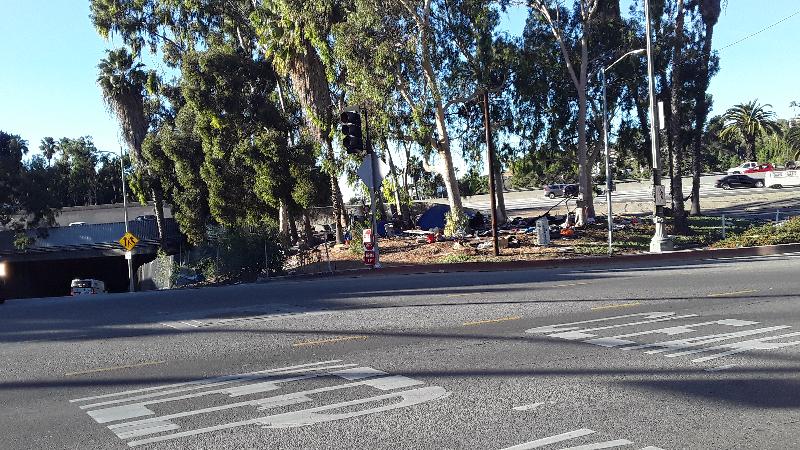

Factors- Why people become Homeless
On their website, BackPackbed.org listed many of the factors that can result in homelessness. It can be caused by a single factor or a combination of factors, such as family violence, mental health issues, physical health issues (for example an accident at work causing mounting bills) loss of employment, under-employment or inability to gain a new job, limited housing/rental stress, traumatic life experience and drug and alcohol addiction, which can often occur after being homeless.
A significant amount of the homeless population has made poor choices, or have underlying economic hardships that have resulted in incarceration. Much of the homeless population have spent time in jail or prison. Lucius Couloute, of The Prison Policy Initiative, a criminal justice-oriented public policy think tank, providing research to expose the broader harm of mass criminalization, in a report “Nowhere to Go: Homelessness among Formerly Incarcerated People,” noted that formerly incarcerated people are “10 times likely to be homeless than the general public.” According to Couloute, barriers to employment, and “explicit discrimination” have created a little-discussed housing crisis. Recidivism, the tendency of convicted criminals to be repeat offenders, comprise a “revolving door” of incarceration and are “more likely” to be homeless. In fact, people who “have been to prison just once,” experience homelessness at a rate nearly 7 times higher than the general public, while those that have been incarcerated more than once have rates that are 13 times higher than the general public.
A paradox for repeat law offenders and homelessness are policies that criminalize homelessness, such as “sleeping in public places,” “panhandling,” “public urination” and other public offenses, which invariably land repeat offenders back in jail, often resulting in a revolving door of perpetual homelessness.
However, the incarcerated, by no means, account for the entirety of the homeless population. With economic hardships already a daily reality for the minority communities due to lack of equal opportunity to wealth and job prospects, more and more families are becoming a part of the homeless population. Ridley-Thomas, of the 10th Council District of Los Angeles, reported that there were 185 families, in his district alone, identified as homeless.
“This to my way of thinking, is unthinkable and unconscionable,” said Ridley-Thomas. “But it’s only a fraction of the crisis that we see at the scale of the City of Los Angeles.”
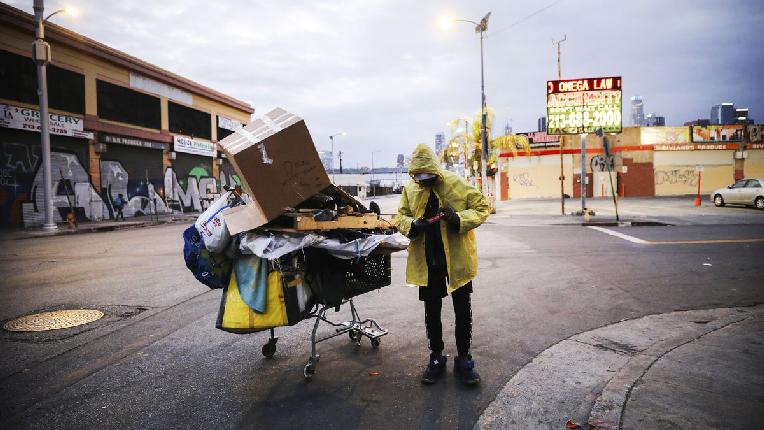
The Homeless Population- Who Are They?
The homeless population in the United States is as varied and diverse as the population of the United States, but much of the homeless population are people of color. According to the National Alliance to End Homelessness, www.endhomelessness.org, African Americans “make up 13 percent of the general population” but “more than 40 percent of the homeless population.” Additionally, the Alliance reports that “on a given night per 10,000 people in the population, Native Hawaiians and Pacific Islanders, have the highest rate of homelessness. American Indians/Alaska natives have the second-highest rate, followed by African Americans, people who identify as two or more races, and Hispanics.”
The scope of homelessness in Los Angeles is staggering, to say the least. In Los Angeles, you’ll notice homeless encampments in almost every major area of the city. In any travels throughout the varying areas of Los Angeles such as Venice/Santa Monica, Pico/Union, Mid-Wilshire, Hollywood, North Hollywood of course, Echo Park … homeless encampments can be found.
On the Front Lines- What Is Being Done?
Near a bridge, off the 101 Freeway, near the Alvarado St. exit, an outreach worker, was spotted at a small park adjacent to the exit, working for an organization called Urban Alchemy which was founded in 2018 to “bring a sense of peace and respect to America’s most chaotic urban areas,” is “struggling with the intersection of extreme poverty, addiction, mental illness and hopelessness,” according to their website, www.urban-alchemy.us. The handsome gentleman, Robert, an African American man with a friendly nature, distinguishable by his mannerisms, easy nature and modest watch on his wrist, indicated a caring not typically associated with the homeless population. He was cleaning the park, watching intently the encampment under the freeway bridge.
“We deal with the homeless,” said Robert. “We get to know the homeless community. We provide a safe place for them to come and use the bathrooms.” His is a simple job, some would believe. However, the reality of his work is much more serious than any observer would pay attention to.
“We’re there in case someone tries to go in there and overdoses (on drugs) or anything. We do know certain things like first aid, me and my co-pilot- we have rescued several people, from ODing in the restroom to Code 3’s (emergency responses).”
When asked about the most heartbreaking aspect of his job, Robert had quite a candid response.
“It’s all in one,” said Robert. “You can stumble upon a dead body. One week we had 4 dead bodies down the street.”
Robert expressed frustration that many workers, who are on the front lines, heroes and heroines who do their absolute best to make a difference, sometimes are simply overwhelmed.
Jose Torres and John Maceri of The People Concern, who also participated in the Empowerment Congress, in a breakout session called “Journeys: Moving from the Streets to a Home,” detailed how their and other organizations are battling to help the homeless population of Los Angeles. Many of these organizations have teams assigned to certain areas of Los Angeles.
“We work with individuals to ensure they have identification, provide them with substance abuse counseling, mental health services and connect them to legal services as needed,” said Jose Torres. “We also partner with organizations to provide medical services, including Covid-19 testing and flu vaccines.”
Robert, of Urban Alchemy noted a problem, a problem at the center of homelessness, a lack of trust of health and social officials, which presents another challenge in the fight against homelessness.
“We can only do what we can to help,” Robert explained. “But it’s up to the next person to want the help. We provide assistance, we try to help, but if you don’t want the help, then what can we do?” Robert has seen and experienced members of the homeless population that resist the opportunity of housing. “I’ve seen many times where they’ve taken people, put them in these hotels,” said Robert. “They stay in these hotels two weeks and then they come back and I’m like ‘what are you doing back out here?’ “Oh, I want to be drunk and dirty, I don’t like being clean, I want to be out in the open. Some people are so set on living free, doing what they want to do. And a lot of people don’t like to be closed in. If you talk to them, they will give you an idea of what they are thinking like.”
John Maceri, of The People Concern, has a realization that trust issues in the homeless community are deeply embedded.
“Often what we find in this work and part of the reluctance for people coming inside is that often they’ve been made promises that have aren’t kept,” said Maceri. “We’ve got to make sure that we have housing that’s readily available.”
Libby Boyce, of the Los Angeles County Department of Health Services (DHS), has worked for the county since 1991. Her job is with the Department of Health Services Housing for Health Division, and oversees “all of the street-based engagement, the interim housing” and a program called Enriched Residential Care, “for those people who need care and supervision, board and care type of housing,” to ensure their “permanency in housing.”
As Robert of Urban Alchemy indicated, trust issues and mental health issues are major factors why many of the homeless remain unhoused.
“There’s a lot of work involved with engaging these (homeless) individuals,” said Libby Boyce. “It is not easy, you don’t just go out and have a conversation and then somebody agrees to come inside, it’s very complicated. There’s very rare cases where that happens where people just agree to come inside. It’s really about trusting the individual that’s working with them.”
”The biggest indicator of success for us, of course is being able to move our unhoused neighbors indoors,” said Torres, of The People Concern. “Being able to offer people housing, especially an apartment is a game-changer. “Torres and The People Concern recently saw some success, albeit limited. “We were able to move 36 people indoors,” he said. “8 people are currently in an apartment and we are working with our teams to move in some more. 20 are matched to vouchers (vouchers, generally from The County can be used for designated hotels in the Los Angeles area) and we are working with our teams to find permanent homes for them, while they live in temporary housing. “
Boyce and Enriched Residential Care are using a model they’ve used previously in the Skid Row area called “C3,” (City, County and Community) which employs a “disaster relief” approach to homelessness.
“We instituted or facilitated four multi-disciplinary teams in the Skid Row area,” said Libby. “Each team had a health provider, a mental health provider, a substance use provider, a case manager and someone with lived experience. They really focused on a small geographic area and got to know everyone that’s homeless in that area and spent time engaging them and building rapport with those individuals and we found that that model really helped to get people to agree to come inside.” Currently, Los Angeles County has expanded that model, with 60 multi-disciplinary teams. “We have split LA County into service planning areas, and there are 8 service planning areas throughout Los Angeles County, and each one has an outreach lead, an agency that leads outreach,” said Boyce. “There are teams for veterans, there are teams for people experiencing mental health instability, there’s a lot of different teams, so you need an entity that can oversee and ensure that all those services are coordinated.”
According to Boyce, teams are assigned to every area in Los Angeles and those teams are responsible for knowing and establishing a rapport with the homeless populations in their respective areas.
However, visits to many of those areas indicate that a monumental amount of work has yet to be accomplished. The problem? Resources.
“It takes a lot of resources,” said Boyce. “If we can do this throughout the County and have a full-time team working on every encampment, we can be much more successful getting people housed, but that takes a tremendous amount of resources. In addition, you have to have housing identified.”
Homeless encampments seem to be a part of the growing landscape of human existence in the United States, and, by appearances, it seems that little is being done to alleviate the ever-expanding problem. Fortunately, there are several organizations, groups and individuals that are on the front lines trying to help the homeless, but often they don’t have the governmental resources or manpower to make a larger impact.
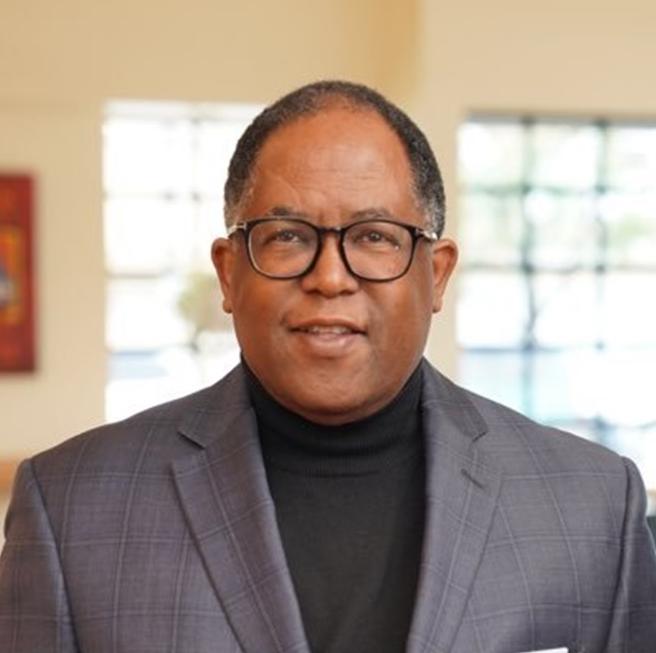
Councilperson Mark Ridley-Thomas (Los Angeles) and the State of California have identified homelessness as an immediate priority, allocating a large portion of the state budget to combat the situation. Ridley-Thomas will be one of the architects of potential change.
“We have a governor (Gavin Newsome) that has made homelessness a priority,” said Ridley-Thomas. “He selected me to be one of the co-chairs of the statewide Task Force on Homelessness, along with the mayor of Sacramento, Bill Steinberg, a former colleague of mine. He’s made it a priority. In his current budget, he‘s allocated nearly 2 billion dollars more aimed at homelessness and specifically tailoring it to the issue of what is known as Project Home Key.”
Project Home Key, a project developed under the California Department of Housing and Community Development (HCD) designed to purchase and develop hotels, buildings and other types of housing and resources for the homeless.
“In LA County 4000 people were brought indoors in the space of three months,” said Ridley-Thomas of the program. “We’re purchasing hotels and other residential environments so that they have permanent supported housing because we’re not interested in turning those persons back onto the streets.”
With economic factors and 1 in 3 people infected with COVID-19 19 in Los Angeles, the problem of homelessness is likely to get worse before things improve for the homeless population. But people on the front lines, encouraged by an influx of budget resources, are continuing their fight against homelessness. Although they have an uphill battle, our social workers, outreach workers, city and state officials are optimistic that homelessness will not be the new normal, especially with added resources, which includes manpower.
“We have the structure,” said Libby Boyce, “that not an issue. It’s the resources, the housing and the people, the bodies that can go out and do this work.”
“Housing changes lives,” said Torres of The People Concern. “The availability of housing resources is the key to ending homelessness.”
Next: Homelessness, the Health Community and Mental Health- What are Health Professionals and Mental Health Professional’s Role in Helping the Homeless?
All photos by Buddy Sampson except where indicated
We Publish News 24/7. Don’t Miss A Story. Click HERE to SUBSCRIBE to Our Newsletter Now!






